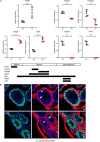The cell adhesion molecule BT-IgSF is essential for a functional blood-testis barrier and male fertility in mice
- PMID: 29123028
- PMCID: PMC5766970
- DOI: 10.1074/jbc.RA117.000113
The cell adhesion molecule BT-IgSF is essential for a functional blood-testis barrier and male fertility in mice
Abstract
The Ig-like cell adhesion molecule (IgCAM) BT-IgSF (brain- and testis-specific Ig superfamily protein) plays a major role in male fertility in mice. However, the molecular mechanism by which BT-IgSF supports fertility is unclear. Here, we found that it is localized in Sertoli cells at the blood-testis barrier (BTB) and at the apical ectoplasmic specialization. The absence of BT-IgSF in Sertoli cells in both global and conditional mouse mutants (i.e. AMHCre and Rosa26CreERT2 lines) resulted in male infertility, atrophic testes with vacuolation, azoospermia, and spermatogenesis arrest. Although transcripts of junctional proteins such as connexin43, ZO-1, occludin, and claudin11 were up-regulated in the absence of BT-IgSF, the functional integrity of the BTB was impaired, as revealed by injection of a BTB-impermeable component into the testes under in vivo conditions. Disruption of the BTB coincided with mislocalization of connexin43, which was present throughout the seminiferous epithelium and not restricted to the BTB as in wild-type tissues, suggesting impaired cell-cell communication in the BT-IgSF-KO mice. Because EM images revealed a normal BTB structure between Sertoli cells in the BT-IgSF-KO mice, we conclude that infertility in these mice is most likely caused by a functionally impaired BTB. In summary, our results indicate that BT-IgSF is expressed at the BTB and is required for male fertility by supporting the functional integrity of the BTB.
Keywords: BT-IgSF (IgSF11); IgCAM; IgCAM BT-IgSF (IgSF11); blood–testis barrier; cell adhesion; connexin43; male fertility; spermatogenesis; testis.
© 2017 by The American Society for Biochemistry and Molecular Biology, Inc.
Conflict of interest statement
The authors declare that they have no conflicts of interest with the contents of this article
Figures






Similar articles
-
Disruption of Sertoli-germ cell adhesion function in the seminiferous epithelium of the rat testis can be limited to adherens junctions without affecting the blood-testis barrier integrity: an in vivo study using an androgen suppression model.J Cell Physiol. 2005 Oct;205(1):141-57. doi: 10.1002/jcp.20377. J Cell Physiol. 2005. PMID: 15880438
-
Establishment, maintenance and functional integrity of the blood-testis barrier in organotypic cultures of fresh and frozen/thawed prepubertal mouse testes.Mol Hum Reprod. 2017 May 1;23(5):304-320. doi: 10.1093/molehr/gax017. Mol Hum Reprod. 2017. PMID: 28333312
-
SOX8 regulates permeability of the blood-testes barrier that affects adult male fertility in the mouse.Biol Reprod. 2013 May 31;88(5):133. doi: 10.1095/biolreprod.112.107284. Print 2013 May. Biol Reprod. 2013. PMID: 23595903 Free PMC article.
-
Blood-testis barrier and Sertoli cell function: lessons from SCCx43KO mice.Reproduction. 2016 Feb;151(2):R15-27. doi: 10.1530/REP-15-0366. Epub 2015 Nov 10. Reproduction. 2016. PMID: 26556893 Review.
-
Intercellular adhesion molecules (ICAMs) and spermatogenesis.Hum Reprod Update. 2013 Mar-Apr;19(2):167-86. doi: 10.1093/humupd/dms049. Epub 2013 Jan 3. Hum Reprod Update. 2013. PMID: 23287428 Free PMC article. Review.
Cited by
-
NECL2 regulates blood-testis barrier dynamics in mouse testes.Cell Tissue Res. 2023 Jun;392(3):811-826. doi: 10.1007/s00441-023-03759-5. Epub 2023 Mar 6. Cell Tissue Res. 2023. PMID: 36872374
-
IGSF11 and VISTA: a pair of promising immune checkpoints in tumor immunotherapy.Biomark Res. 2022 Jul 13;10(1):49. doi: 10.1186/s40364-022-00394-0. Biomark Res. 2022. PMID: 35831836 Free PMC article. Review.
-
[IGSF11: A Novel Target for Cancer Immunotherapy].Zhongguo Fei Ai Za Zhi. 2025 May 20;28(5):371-378. doi: 10.3779/j.issn.1009-3419.2025.106.14. Zhongguo Fei Ai Za Zhi. 2025. PMID: 40506491 Free PMC article. Review. Chinese.
-
Copy Number Variation Mapping and Genomic Variation of Autochthonous and Commercial Turkey Populations.Front Genet. 2019 Oct 29;10:982. doi: 10.3389/fgene.2019.00982. eCollection 2019. Front Genet. 2019. PMID: 31737031 Free PMC article.
-
IgSF11 regulates osteoclast differentiation through association with the scaffold protein PSD-95.Bone Res. 2020 Feb 10;8:5. doi: 10.1038/s41413-019-0080-9. eCollection 2020. Bone Res. 2020. PMID: 32047704 Free PMC article.
References
-
- Suzu S., Hayashi Y., Harumi T., Nomaguchi K., Yamada M., Hayasawa H., and Motoyoshi K. (2002) Molecular cloning of a novel immunoglobulin superfamily gene preferentially expressed by brain and testis. Biochem. Biophys. Res. Commun. 296, 1215–1221 - PubMed
-
- Katoh M., and Katoh M. (2003) IGSF11 gene, frequently up-regulated in intestinal-type gastric cancer, encodes adhesion molecule homologous to CXADR, FLJ22415 and ESAM. Int. J. Oncol. 23, 525–531 - PubMed
-
- Matthäus C., Langhorst H., Schütz L., Jüttner R., and Rathjen F. G. (2017) Cell–cell communication mediated by the CAR subgroup of immunoglobulin cell adhesion molecules in health and disease. Mol. Cell. Neurosci. 81, 32–40 - PubMed
-
- Eom D. S., Inoue S., Patterson L. B., Gordon T. N., Slingwine R., Kondo S., Watanabe M., and Parichy D. M. (2012) Melanophore migration and survival during zebrafish adult pigment stripe development require the immunoglobulin superfamily adhesion molecule Igsf11. PLoS Genet. 8, e1002899. - PMC - PubMed
-
- Harada H., Suzu S., Hayashi Y., and Okada S. (2005) BT-IgSF, a novel immunoglobulin superfamily protein, functions as a cell adhesion molecule. J. Cell. Physiol. 204, 919–926 - PubMed
Publication types
MeSH terms
Substances
Grants and funding
LinkOut - more resources
Full Text Sources
Other Literature Sources
Molecular Biology Databases
Research Materials

